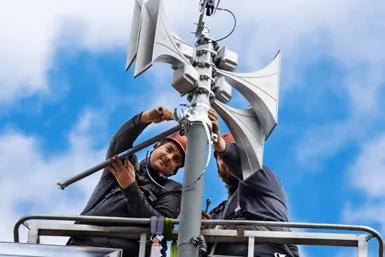Multifunctional sirens for fail-safe crisis communication
In crisis situations, it is essential that authorities and emergency services act quickly and purposefully, provide immediate assistance and ensure that information is exchanged efficiently and warnings and emergency calls are transmitted.
To achieve this, reliable communication channels must be in place between the disaster control authorities, critical infrastructure and the population, which also function in the event of a communication network or power supply failure. In the past, the Saxon city of Meißen was flooded by two floods of the century. in 2002, 21 people died in Saxony and the damage in the Free State alone amounted to around six billion euros. in 2013, the Elbe and its tributaries burst their banks again, again causing extensive damage and claiming lives. These disasters are becoming more frequent due to climate change.
As part of a grant from the Federal Ministry of Education and Research (BMBF) to develop solutions for civil security, the district of Meißen has therefore launched the Crisis Communication (Kri-Kom) project to develop a self-sufficient, integrative communication system that is independent of existing communication infrastructures.
Resilient warning system with multifunctional sirens
Six project partners have come together in phase two (October 2023 to September 2027). They are developing models for direct communication between all stakeholders, including the population, in the event of a crisis - even if the communication and power supply fails. HÖRMANN Warnsysteme is playing a central role in the development of this pioneering system and is contributing its expertise in the field of siren warning systems.
"With its independence from the power grid, the siren is predestined to be a warning device that is integrated into fail-safe crisis communication. The requirement is for a multifunctional siren that is integrated into comprehensive infrastructures," explains Anna Hörmann, Managing Director of HÖRMANN Warnsysteme. Thanks to this unique technology, multifunctional siren sites and digital bulletin boards can be used for alert communication and emergency call transmission, further improving the effectiveness and reach of the system.
Resilient crisis communication for the future
The project presented HÖRMANN Warning Systems with particular challenges, especially in terms of integrating the various communication systems and ensuring they work together smoothly under extreme conditions. However, thanks to close cooperation with the project partners and continuous research and development, the employees were able to successfully overcome this challenge. Another important aspect was the consideration of the specific requirements of the regional conditions, which required tailor-made solutions.
The district of Meißen leads the consortium. The project participants are KomRe AG as an expert in crisis communication, the h2 Magdeburg- Stendal University of Applied Sciences, the Hasso Plattner Institute for Digital Engineering, the company snafu Gesellschaft für Interaktive Netzwerke mbH, a system integrator for security networks, and HÖRMANN Warnsysteme as a manufacturer of and expert in siren warning systems. In addition, 19 important local stakeholders - from BOS, KRITIS and municipalities - are involved as associated partners in order to successfully implement the project directly in practice with local requirements. The basis for the KriKom-LK-MEI project is the already established, self-sufficient crisis communication system consisting of portable disaster control lighthouses (Kat lighthouses) in the district of Meißen.
The feedback from the project partners and the population actively involved in the system tests was consistently positive. The KriKom project has already received great recognition and is expected to serve as a model project for other municipalities. Initial inquiries for follow-up projects also show how well received the solutions from HÖRMANN Warnsysteme are.
The aim is to provide a functional, fail-safe KriKom radio data network at the end of the project. It will be extensively tested with the active participation of the population and should also be transferable to other municipalities. Anna Hörmann: "A fail-safe infrastructure to protect the population requires the integration and communication of the various systems with each other, including the sirens. The KriKom project is very important to us as part of the developments with which we are continuing to shape the future of sirens." Technical precision and partnership-based cooperation are the basis for sustainable energy infrastructure.
